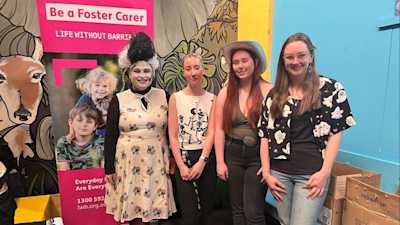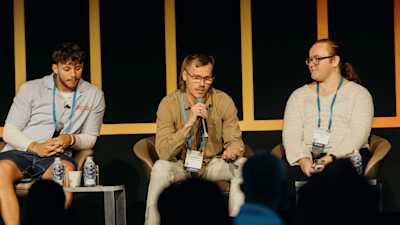"I joined the Youth Advisory Group because I thought that it would be a great way to have my voice heard and not just advocate on one level, but also advocate systemically," Tara said.

Image: Toby and Tara sit next to each other on a black lounge. Tara is wearing a light blue knit and jeans, Toby is wearing a white t-shirt and black jeans.
Lived experience is a powerful lens through which to understand and navigate the world. In the out-of-home care sector, lived experience refers to the insights, knowledge, and understanding that individuals gain through their direct experiences with the foster care system. At Life Without Barriers, one of the ways we do this is through a Youth Advisory Groups (YAG).
Our Youth Advisory Groups are networks of young people who participate in providing feedback on, and co-designing our services. Last year, 62 YAG participants were involved in lived experience empowerment activities. Their voices have started to shape the care young people receive from us—from activities in residential houses to feedback for carers and to Life Without Barriers’ future technology transformation.
Recently, Carly Jacobitz, Deputy Chief Executive for Child, Youth and Family at Life Without Barriers, sat down with Tara and Toby, two care leavers who are now in the 20s, to have a conversation about how we bring lived experience into the work that we do in Child, Youth and Family.
Here is what they had to say.
Carly: Can you tell us a little bit about yourself and how you got involved at Life Without Barriers and our Youth Advisory Group?
"I am from Tasmania, and I originally was with Life Without Barriers when I was in foster care. Then left for a while, and now that I'm out of care, I was asked to come and be a part of the National Youth Advisory Group," Tara shared.
"My story is a little bit longer. I also was in foster care with Life Without Barriers and then, later in my adult life, early young adult life, I was working with Create Foundation and Life Without Barriers reached out for a youth expert advisor and I came along. It's great," Toby said.
Carly: You sit in on some of the face-to-face senior leadership team meetings that we have. Tell us about what that is like and how it is that you bring your voice into those meetings.
"I think one part of the way I do it is just by existing in the room. I think that there's a little bit of accountability that people hold themselves to that's a bit higher." Toby said.
"They often stop themselves and then rephrase, and it's really interesting to see that me being there gives them that extra consideration."
It is really important to the senior leadership team to remember that their accountability is first and foremost to the children and young people that they support Carly reflected.
"I absolutely agree that having you in the room in those meetings really puts that accountability front and centre."

Image: Tara, Carly and Toby sit together at a high table.
Carly: Tara, can you tell us why you joined the Youth Advisory Group and what that experience has been like for you?
"I joined the Youth Advisory Group because I thought that it would be a great way to have my voice heard and not just advocate on one level, but also advocate systemically," Tara said.
"Quite a lot of the work I do is around advocating systemically and making sure the organisations and the government are focusing on what's best for children and young people."
"So far my experience with the Youth Advisory Group has been amazing. I love the meetings. I love the people. I love the members of the organisation that come along to the meetings. Recently I've been a part of the training for Family Time, which focuses on family reunification."
Fundamentally, to contribute to that systemic change, we have to bring the voice of children and young people into that work Carly shared.
Carly: What is it that you'd like to achieve in the future through the Youth Advisory Group?
"I’d really love to see sibling engagement from young people—like having the Youth Advisory Group as a long-term thing in general, " said Toby.
"It changes people's lives when they get to have a say about their lives. That is so powerful. I also hope to see people not having to advocate for the same things I advocated for."
"I want to see that actual shift so instead of fighting for our rights, fighting for the things that help us thrive."
Tara agreed with Toby and said she hopes to see smaller changes as well.
"I want to see changes to the way that children and young people get to live their lives every day," she said.
"That and hopefully more of a young person-centred focus around research and policy development."
Toby was in foster care along with his siblings, he shared that keeping siblings together is a change he wants to see prioritised.
"As someone who's left care, one of the big things that contributed to who I am today and how well I'm doing in my life is that I was with my sisters throughout my care experience."
Tara said that she wants to see more connection.
"More connection to foster carers, caseworkers, siblings. It is really hard when you don't even have a single person that you feel like you can constantly go to and constantly connect with," Tara added.
At Life Without Barriers, we are incredibly fortunate to have voices like Toby and Tara’s to inform the work that we do and really help shape our policy and practice.
When we bring practice and we bring the voice of lived experience and we bring policy all together, that's where we can really start to see some change.
Life Without Barriers believe in keeping families together. Where possible, we try to keep brothers and sisters together when finding carers. Fostering sibling groups is providing either short or long-term-care and support for siblings from the same family. Sibling Carers provide care for two or more related children. Keeping siblings in the same foster home helps them to feel safe and helps them settle in faster.


